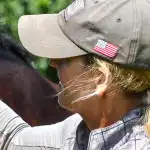
The monster-sized garbage truck was headed straight for the horse I was riding down busy Columbus Avenue, at the height of evening rush hour on New York City’s Upper West Side. Gears grinding loudly, the vehicle kept chugging toward us as I maneuvered my horse as close as possible to the parked cars along the curb in an attempt to avoid a truck-horse-human collision.
The perpetually rearing wooden horse still stares out the enormous picture window oblivious to the constant bustle of New York City, just as he’s done since 1912. All around him, the world has changed. The once plentiful shops offering equestrian accouterments to clients with names like Rockefeller and Kennedy have disappeared, leaving Manhattan Saddlery as the sole surviving tack shop in the borough.
It was 8:45 p.m. on a Thursday evening. It was dark, wet and cold outside. I had 24 hours until the chili cook-off fundraiser I’d been planning for the Area II Young Riders, and the anxiety was setting in, as it always does before any function I plan.
I was doing my best to balance my time between my full-time job at Sinead Halpin Eventing, my part-time job at Prestige Saddles, my commitment to Young Riders, my part-time job teaching at River Edge Farm, and my personal commitment to fitness.
At first glance, the riders in the performance show Cavalia don’t appear to have much in common with their counterparts in the show ring or out on the cross-country course. Colorful costumes, fancy trick riding and elaborate sets have more in common with the circus than horse showing.
Dashdorji, also known as Dasher, was born in the Mongolian countryside and grew up with animals as a part of his life. At a young age he started down the path as an artist, and he eventually received attention and training in his native country.
After Dasher moved to the United States, a chance meeting enabled him to forge a connection to The Beresford Gallery while he had a job cleaning stalls at a Maryland farm.
Artist Pat Turcotte, Lakewood, N.Y., specializes in equestrian illustration and portraiture, most specifically eventing. She also enjoys child portraiture and works primarily in watercolor, although she does accept commissions in oil.
This week’s cover, Highland Hogan And Becky Holder, shows the pair enjoying a quiet moment during a horse inspection.
Gigolo FRH, a six-time Olympic medalist and arguably the most successful dressage horse in history, was euthanized Sept. 23 after he suffered complications from an injury. He was 26.
Gigolo was bred by Horst Kulssmann in 1983. In 1989, Isabell Werth’s then-trainer and sponsor, Uwe Schulten-Baumer, purchased the horse for Werth to ride.
Fuerst Gotthard, a respected sport horse stallion and winner of multiple grand prix jumping competitions, died of age-related issues on Sept. 24. He was 26.
The gray Oldenburg was bred at Gestut Vorwerk, Germany, and imported into the United States as a 3-year-old.
At his Oldenburg licensing, Fuerst Gotthard (First Gotthard—Elisa, Inschallah) scored multiple 8s and was reserve champion of his 100-day test in Culpeper, Va., where he received 9s for ability to work, general jumping ability and cross-country, and an overall score of 132.24 points.

By submitting your email, you agree to our Terms of Service and Privacy Policy. You may also receive promotional emails from The Chronicle of the Horse. You can opt out at any time.
For Customers
Company
Terms of Use